You cannot miss Miso for your authentic Japanese cooking. Miso is one of the most frequently used ingredients for Japanese food.
In the past, most Japanese people used to make homemade miso in their homes and were proud of their miso as an achievement of their effort and time. Disappointingly, homemade miso is becoming less common nowadays and most people buy Miso at supermarkets.
I was not a big fan of Miso, to be honest with you. However, since I moved to Canada where it is not easy to find a decent Miso at the supermarket I have started making Miso at home.
Making Miso is not very complicated. I have already tried a few times and I love making Miso now. It is good that I no longer have to go to the shops to find my favourite Miso and end up being frustrated when it’s not available. Homemade Miso is also free from food additives.
I am going to share my recipe of homemade Miso. I hope that it’s helpful to enrich your food life.
The secret of Miso taste
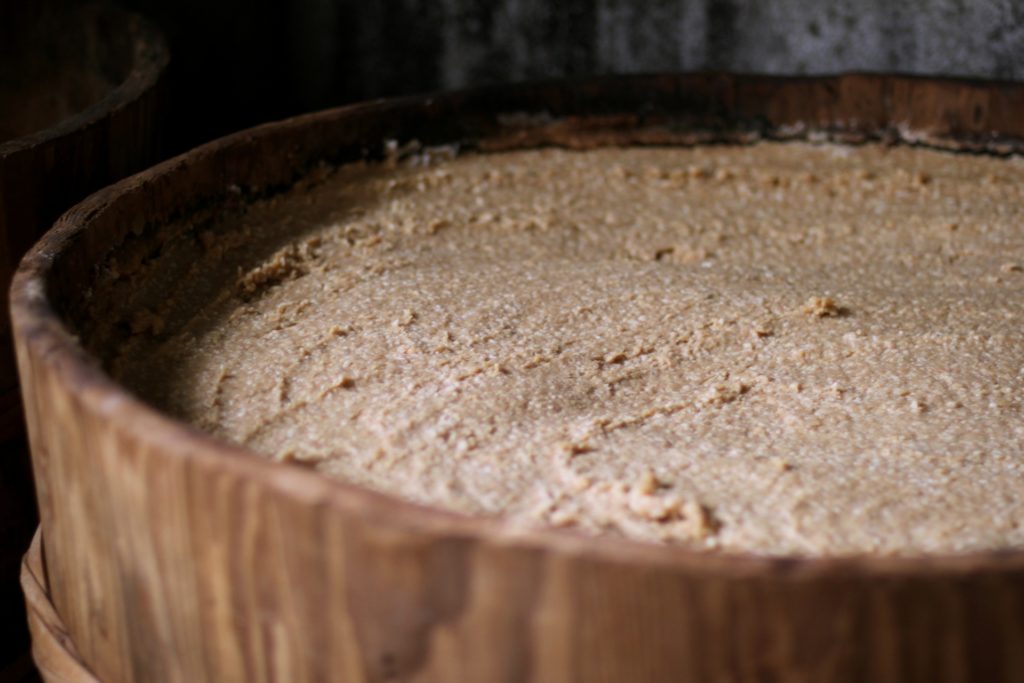
Miso stored in a wooden bucket
The ingredients of miso are very simple: soybeans, Koji and salt. Is it amazing that such a simple raw material can create such a deep and signature flavour?
The secret of its taste is the Koji.
Koji fungi provides enzymes such as “amylase” which break down starch or “protease” which digests protein. They change the starch of soybeans into sugar which lactic acid bacteria and yeast love, while they also turn protein into amino acids and peptides which bring umami and the rich flavour.
Unlike other types of yeast, the lactic acid bacteria and yeast born in this process uniquely have “salt tolerance” that allows them to grow even in concentrated salt.
These yeasts also generate alcohol (alcohol fermentation) and carbon dioxide and create a distinctive aroma of miso.
The various substances produced by yeast and lactic acid bacteria culture the rich and complex taste of Miso as a result.
Type of Miso and Koji
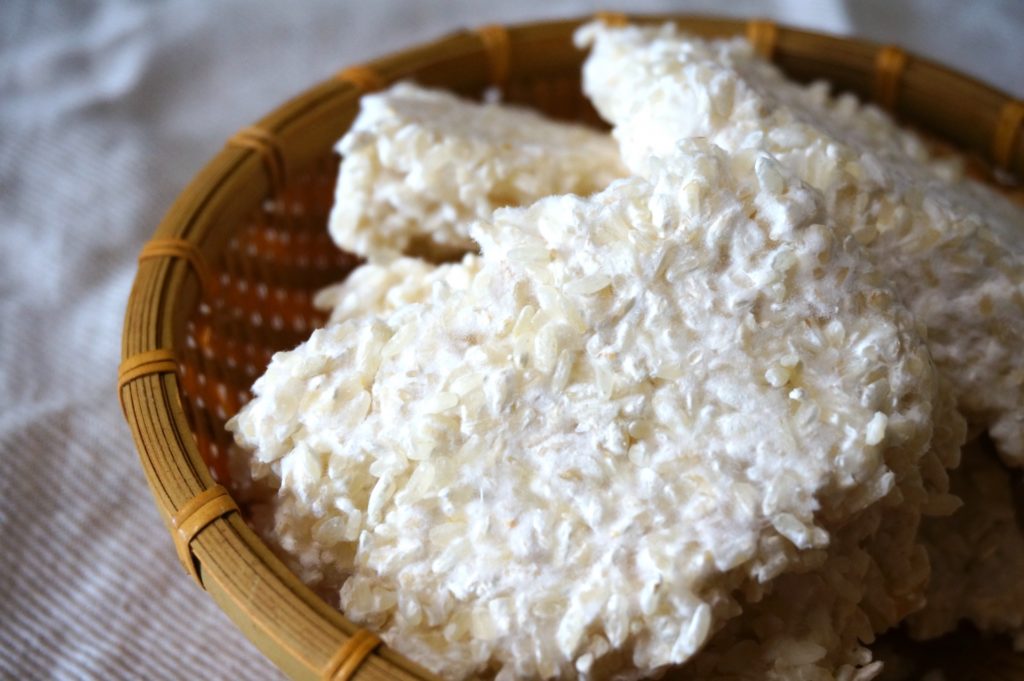
Rice Koji, block type
Koji is a type of mould or fungi, and it plays an important role in making sake, soy sauce, miso (soybean paste), mirin, rice vinegar, and Shio Koji.
Miso is made of soybeans and there are three types of Miso depending on which Koji is used.
Rice Koji – “Kome Koji”
“Kome miso (rice miso)” or “Koji Miso” is made with rice Koji. This is the most popular and widely used. It has a good aroma and sweeter taste compared with other types of Miso.
Since we can get rice Koji more easily than other Koji, I always make Miso with rice Koji and I will explain how to make Miso with rice Koji in this article.
Barley Koji – “Mugi Koji”
“Mugi miso” is normally made with barley Koji although there is also “Mugi miso” made of wheat Koji. It has a whitish colour, unique sweetness and a deep taste. It’s suitable for dishes that you eat miso as it is. More popular in Kyushu, Chugoku and Shikoku regions rather than other parts of Japan.
Bean Koji – “Mame Koji”
“Mame miso” which is made with soybean Koji is mainly produced in Nagoya city and around. The ageing period of “Mame miso” is longer than other types of Miso and it has a dark reddish-brown colour, less sweetness and strong umami taste.
How to make Miso (Bean Paste)
There are various types of miso, but here I introduce the basic “Kome miso” with rice Koji.
You may think it’s difficult to make homemade miso, but the ingredients are simple. It’s also a nice feeling to be sure your Miso doesn’t contain any food additives. So why don’t you try?
You may need
- Preparation container (5-6 litre enamel, ceramic or plastic container)
- A large pan for boiling soybeans
- A large bowl and a colander
- Tools for crushing soybeans, such as mashers
Ingredients for 5kg of Miso
- Soybean: 1kg
- Rice Koji: 1-2kg
- Salt: 500g
1 Soybean Preparation
1: Wash the soybeans with water. Remove floating beans and then wash them by rubbing the soybeans with the palm of your hand, change the water and wash thoroughly 3-5 times.
2: Place the washed soybeans in a large pan and with 3-4 times their quantity in water. Soak the soybeans overnight (12-18 hours), until the soybeans double in size.
3: Put the soybeans and enough water to cover the beans into a large pan and boil on a high heat until they are boiled. Scoop off the scum from the water surface while it boils. Simmer them on a low heat for about 3 to 6 hours until they soften. The soybeans must be soft enough to be easily crushed between your thumb and little finger.
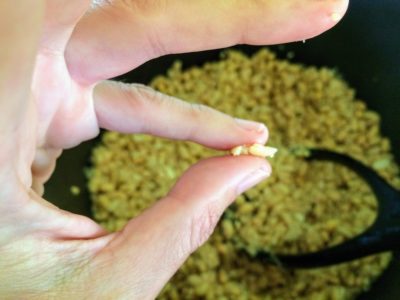
Make sure the beans are soft enough to be easily broken with your fingers
4: After the soybeans have simmered, drain the soybeans with a colander, but keep the broth for use afterwards.
5: Mash the soybeans. Put them in a thick plastic bag and mash them with a gloved palm or a rolling pin, or put them in a bowl and mash them with a masher.
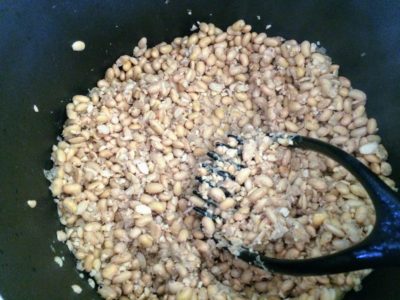
Mash the boiled beans
6: Leave it until cool down.
2 Koji Preparation
Take about 50g of salt and put to one side because you will need to use it later. Place the rest of salt (if for example you want to use 500g of salt in total you would now take 450g) and the Rice Koji in a bowl, mix well until the Koji and salt are evenly distributed. (It’s called “Shio-kiri Koji”)
3 Making Miso
1: After the soybeans have cooled down to about room temperature, add Koji (which has already been salted – see Section 2) and mix well. Add the bean broth to adjust the hardness, it should be as soft as your earlobe:)
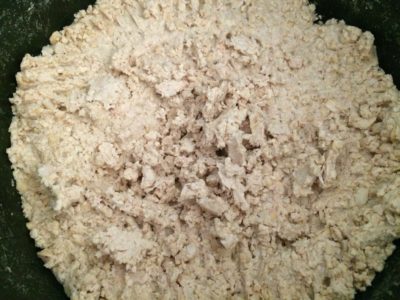
Mix the soybeans and Rice Koji attached with salt
2: When it gets to the appropriate hardness, roll it up into balls to make sure there is no air inside.
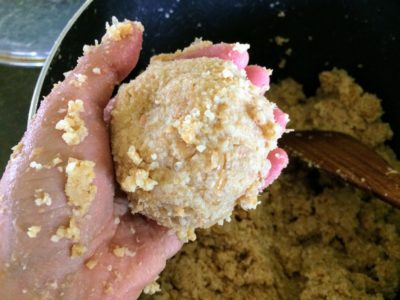
Roll it up into balls
3: Place the Miso balls in a container for fermentation while pushing them one by one, in order to leave as little air possible. After placing all of them, flatten the surface and sprinkle the remaining salt on the edge of the container.
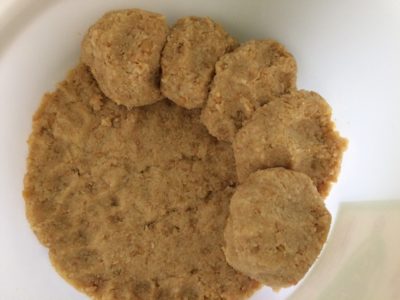
Place the Miso balls in a container without the gap
4: Cover the surface of the miso with a plastic wrap, place the inner lid (pushing lid) and put a 1-2kg weight on it, and then cover it with a lid or newspaper so that nothing enters the container.

Flatten the surface with fingers to squeeze the air out
5: The preparation is now complete. You can eat as early as half a year to a year. (A place with about 27 ℃ is ideal for fermentation and ageing)
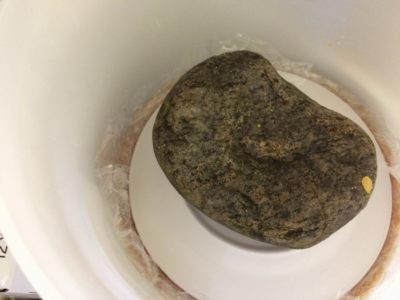
Put a stone to press the bean paste
6: Turn it over with a spatula once every 3-4 months. This is called “Kirikaeshi” in order for the fermentation to proceed smoothly and evenly. Remove mould if there is any at the same time. Put a new plastic wrap to cover again and you can add a slightly lighter weight.

After 3 months of fermentation
7: After six months, taste test the miso until it’s fermented to the stage that you like.
8: When it’s fermented enough, divide it into small portions and store it in the refrigerator.
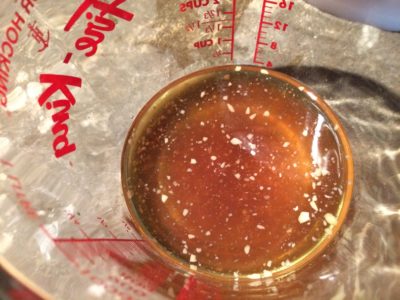
The supernatant that accumulates during the fermentation process is the primitive soy sauce.
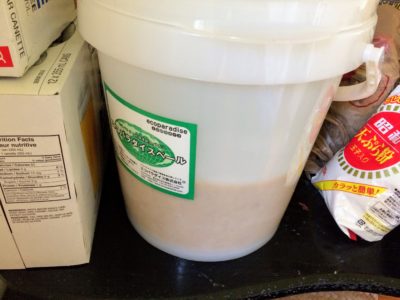
I store it in a plastic bucket
Enjoy making your homemade Miso
It takes a little time to prepare, but once you’ve prepared it, just wait for the fermentation.
The world of miso seems to be profound even though it is a simple material. The taste and flavour of homemade Miso changes depending not only on the ingredients and conditions but also on the amount of koji and the ageing period because it is simple food.
I love making Miso and my homemade Miso has a slightly different taste every time I make it.
In Japanese, the term of “Temae-Miso (homemade Miso)” is a classic metaphor of “being proud” or “self-praise”. It’s often used when someone praises themselves or their family. It’s because making homemade Miso used to be a part of their lives and each home had a signature flavour of Miso.
Miso is one of the most important parts of Japanese food culture, and you can also culture homemade bean paste with your flavour!



